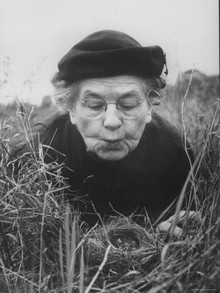
Margaret Morse Nice was an American ornithologist, ethologist, and child psychologist who made an extensive study of the life history of the song sparrow and was author of Studies in the Life History of the Song Sparrow (1937). She observed and recorded hierarchies in chicken about three decades ahead of Thorleif Schjelderup-Ebbe who coined the term "pecking order". After her marriage, she made observations on language learning in her children and wrote numerous research papers.
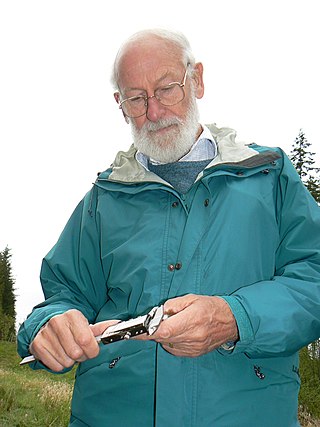
Peter Raymond Grant and Barbara Rosemary Grant are a British married couple who are evolutionary biologists at Princeton University. Each currently holds the position of emeritus professor. They are known for their work with Darwin's finches on Daphne Major, one of the Galápagos Islands. Since 1973, the Grants have spent six months of every year capturing, tagging, and taking blood samples from finches on the island. They have worked to show that natural selection can be seen within a single lifetime, or even within a couple of years. Charles Darwin originally thought that natural selection was a long, drawn out process but the Grants have shown that these changes in populations can happen very quickly.

Percy Roycroft Lowe was an English surgeon and ornithologist.
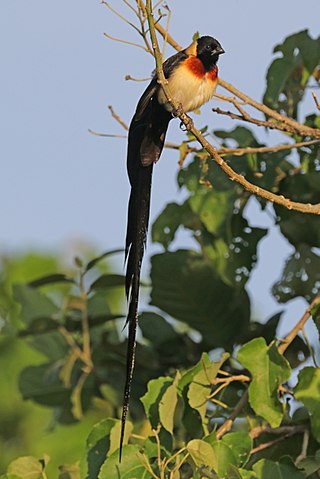
The long-tailed paradise whydah or eastern paradise whydah is from the family Viduidae of the order Passeriformes. They are small passerines with short, stubby bills found across Sub-Saharan Africa. They are mostly granivorous and feed on seeds that have ripen and fall on the ground. The ability to distinguish between males and females is quite difficult unless it is breeding season. During this time, the males molt into breeding plumage where they have one distinctive feature which is their long tail. It can grow up to three times longer than its own body or even more. Usually, the whydahs look like ordinary sparrows with short tails during the non-breeding season. In addition, hybridization can occur with these paradise whydahs. Males are able to mimic songs where females can use that to discover their mate. However, there are some cases where females don't use songs to choose their mate but they use either male characteristics like plumages or they can have a shortage of options with song mimicry. Paradise whydahs are brood parasites. They won't destroy the eggs that are originally there but will lay their own eggs in other songbirds nest. Overall, these whydahs are considered least concerned based on the IUCN Red List of threatened species.
Robert Berkeley Payne is an ornithologist, professor and curator at the Museum of Zoology and Department of Ecology and Evolutionary Biology, University of Michigan.
Frances Crews James is an American ecologist who served as a Professor of Biological Sciences at Florida State University.
The Loye and Alden Miller Research Award, now known as the AOS Miller Award, was established in 1993 by the Cooper Ornithological Society (COS) to recognize lifetime achievement in ornithological research. The namesakes were Loye H. Miller and his son Alden H. Miller, both of whom focused largely on ornithology.
Richard T. Holmes is an American ornithologist. He was the 2002 recipient of the Cooper Ornithological Society’s Loye and Alden Miller Research Award, which is given in recognition of lifetime achievement in ornithological research. He was also awarded the 2002 Margaret Morse Nice Medal by the Wilson Ornithological Society.

Robert Eric Ricklefs is an American ornithologist and ecologist. He was the Curators' Professor of Biology at the University of Missouri, St. Louis from 1996 until August 2019.
The Wilson Ornithological Society (WOS) is an ornithological organization that was formally established in 1886 as the Wilson Ornithological Chapter of the Agassiz Association. It is based at the Museum of Zoology, University of Michigan, Ann Arbor, United States. It was named after Alexander Wilson, a prominent early American ornithologist. The name of the group later evolved through being generally known as the Wilson Ornithological Club until it became the WOS in 1955. It publishes the Wilson Journal of Ornithology. It is a member of the Ornithological Council.
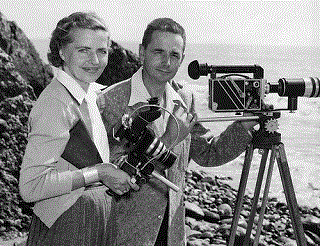
Olin Sewall Pettingill Jr. was an American naturalist, author and filmmaker, president of the Wilson Ornithological Society from 1948 to 1950, a member of the board of directors of the National Audubon Society from 1955 to 1974, and a Life Fellow of the American Ornithologists' Union.
Doris Louise Huestis Speirs was a Canadian ornithologist, artist and poet. The "Doris Huestis Speirs Award" is an annual prize bestowed by the Society of Canadian Ornithologists to "an individual who has made outstanding lifetime contributions in Canadian ornithology". A member of the Art Students' League of Toronto and an art patron, she was the first Canadian to buy a Georgia O'Keeffe painting.
Edward "Jed" Howland Burtt Jr. was an American ornithologist, writer, and educator, and was responsible for many discoveries in ornithology.
Amelia Rudolph Laskey was an American amateur naturalist and ornithologist noted for her contributions to the understanding of bird behavior. Though an autodidact without formal scientific training, Laskey made many original contributions to the field of ornithology and published in reputable scientific journals. Many publications refer to her as Mrs F.C. Laskey.
Ellen D. Ketterson is an American evolutionary biologist, behavioral ecologist, neuroendocrinologist and ornithologist best known for her experimental approach to the study of life-history trade-offs in a songbird, the Dark-eyed Junco. She is currently a Distinguished Professor of Biology, Director of the Environmental Resilience Institute, and affiliate professor in Cognitive Science, Gender Studies, Integrative Study of Animal Behavior, and Neuroscience at Indiana University.

Donald Eugene Kroodsma is an American author and ornithologist, one of the world's leading experts on the science of birdsong.
Glen Everett Woolfenden (1930–2007) was an American ornithologist, known for his long-term study of the Florida scrub jay population at Archbold Biological Station near Lake Placid, Florida. He established what became "the longest continuous population study of any avian species that does not nest in boxes."
Bette Ann Loiselle is an American neotropical ornithologist, neotropical ecologist, and conservation biologist.
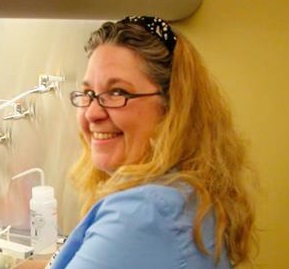
Elaina Marie Tuttle was an American behavioral geneticist and biology professor whose academic research focused on ornithology and study of the white-throated sparrow. During her graduate and post-doctoral work, she investigated how bird sexual selection has evolved and the trade-offs in reproduction that have occurred alongside sperm competition mechanisms in sparrows and in the fairy wren. Her last major publication in 2016 discussed the evolution of a sexual "supergene" in the white-throated sparrow that has created a complementary pair of genetic sexes in addition to the W and Z sex chromosomes found in birds. The decades of work researching the sparrow at the Cranberry Lake Biological Station (CLBS) for Indiana State University resulted in her being given multiple awards and the President's Medal for her accomplishments.







